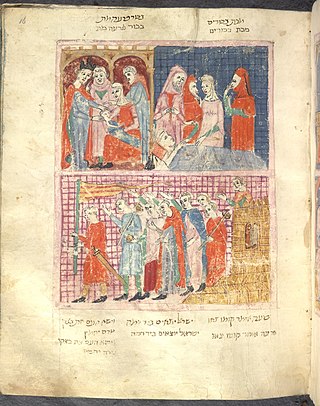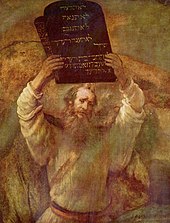
The Book of Joshua is the sixth book in the Hebrew Bible and the Old Testament, and is the first book of the Deuteronomistic history, the story of Israel from the conquest of Canaan to the Babylonian exile. It tells of the campaigns of the Israelites in central, southern and northern Canaan, the destruction of their enemies, and the division of the land among the Twelve Tribes, framed by two set-piece speeches, the first by God commanding the conquest of the land, and, at the end, the second by Joshua warning of the need for faithful observance of the Law (torah) revealed to Moses.
The Book of Numbers is the fourth book of the Hebrew Bible and the fourth of five books of the Jewish Torah. The book has a long and complex history; its final form is possibly due to a Priestly redaction of a Yahwistic source made sometime in the early Persian period. The name of the book comes from the two censuses taken of the Israelites.

Deuteronomy is the fifth book of the Torah, where it is called Devarim and the fifth book of the Hebrew Bible and Christian Old Testament.

Joshua, also known as Yehoshua, Jehoshua, or Josue, functioned as Moses' assistant in the books of Exodus and Numbers, and later succeeded Moses as leader of the Israelite tribes in the Book of Joshua of the Hebrew Bible. His name was Hoshea the son of Nun, of the tribe of Ephraim, but Moses called him "Yehoshua", the name by which he is commonly known in English. According to the Bible, he was born in Egypt prior to the Exodus.
The Book ofLeviticus is the third book of the Torah and of the Old Testament, also known as the Third Book of Moses. Many hypotheses presented by scholars as to its origins agree that it developed over a long period of time, reaching its present form during the Persian Period, from 538 to 332 BC, although this is disputed.

In Abrahamic religions, Moses was a prophet who led the Israelites out of slavery in the Exodus. He is considered the most important prophet in Judaism and Samaritanism, and one of the most important prophets in Christianity, Islam, the Baháʼí Faith, and other Abrahamic religions. According to both the Bible and the Quran, God dictated the Mosaic Law to Moses, which he wrote down in the five books of the Torah.

The Torah is the compilation of the first five books of the Hebrew Bible, namely the books of Genesis, Exodus, Leviticus, Numbers and Deuteronomy. In Christianity, the Torah is also known as the Pentateuch or the Five Books of Moses. In Rabbinical Jewish tradition it is also known as the Written Torah. If meant for liturgic purposes, it takes the form of a Torah scroll. If in bound book form, it is called Chumash, and is usually printed with the rabbinic commentaries.

According to the Hebrew Bible, the tabernacle, also known as the Tent of the Congregation, was the portable earthly dwelling of God used by the Israelites from the Exodus until the conquest of Canaan. Moses was instructed at Mount Sinai to construct and transport the tabernacle with the Israelites on their journey through the wilderness and their subsequent conquest of the Promised Land. After 440 years, Solomon's Temple in Jerusalem superseded it as the dwelling-place of God.

In the Book of Exodus, the Plagues of Egypt are ten disasters that Yahweh inflicts on the Egyptians to convince the Pharaoh to emancipate the enslaved Israelites, each of them confronting the Pharaoh and one of his Egyptian gods; they serve as "signs and marvels" given by Yahweh in response to the Pharaoh's taunt that he does not know Yahweh: "The Egyptians shall know that I am the LORD". These Plagues are recited by Jews during the Passover Seder.

According to the Torah and the Quran, the golden calf was a cult image made by the Israelites when Moses went up to Mount Sinai. In Hebrew, the incident is known as "the sin of the calf". It is first mentioned in the Book of Exodus.

The Jahwist, or Yahwist, often abbreviated J, is one of the most widely recognized sources of the Pentateuch (Torah), together with the Deuteronomist, the Priestly source and the Elohist. The existence of the Jahwist text is somewhat controversial, with a number of scholars, especially in Europe, denying that it ever existed as a coherent independent document. Nevertheless, many scholars do assume its existence. The Jahwist is so named because of its characteristic use of the term Yahweh for God.

The Exodus is the founding myth of the Israelites whose narrative is spread over four of the five books of the Pentateuch. The narrative of the Exodus describes a history of Egyptian bondage of the Israelites followed by their exodus from Egypt through a passage in the Red Sea, in pursuit of the Promised Land under the leadership of Moses.

The Ritual Decalogue is a list of laws at Exodus 34:11–26. These laws are similar to the Covenant Code and are followed by the phrase "Ten Commandments". Although the phrase "Ten Commandments" has traditionally been interpreted as referring to a very different set of laws, in Exodus 20:2–17, many scholars believe it instead refers to the Ritual Decalogue found two verses earlier.

The Song of the Sea is a poem that appears in the Book of Exodus of the Hebrew Bible, at Exodus 15:1–18. It is followed in verses 20 and 21 by a much shorter song sung by Miriam and the other women. The Song of the Sea was reputedly sung by the Israelites after their crossing the Red Sea in safety, and celebrates their freedom after generations of slavery and oppression by the Egyptians.
Richard Elliott Friedman is an American biblical scholar, theologian, and translator who currently serves as the Ann and Jay Davis Professor of Jewish Studies at the University of Georgia.

Zipporah at the Inn is the name given to an episode alluded to in three verses in the 4th chapter of the Book of Exodus. The much-debated passage is one of the more perplexing conundrums of the Torah due to ambiguous references through pronouns and phrases with unclear designations. Various translations of the Bible have sought to make the section clearer through a restructuring of the sentences with a more indirect, yet more straightforward, interpretation.

"Thou shalt not make unto thee any graven image" is an abbreviated form of one of the Ten Commandments which, according to the Book of Deuteronomy, were spoken by God to the Israelites and then written on stone tablets by the Finger of God. It continues, "... any graven image, or any likeness [of any thing] that [is] in heaven above, or that [is] in the earth beneath, or that [is] in the water under earth: Thou shalt not bow down thyself to them, nor serve them."

The pillar of fire and pillar of cloud are a dual theophany described in various places in the first five books of the Hebrew Bible. The pillars are said to have guided the Israelites through the desert during the Exodus from Egypt. The pillar of cloud provided a visible guide for the Israelites during the day, while the pillar of fire lit their way by night.
The Exodus is the founding myth of the Israelites. The scholarly consensus is that the Exodus, as described in the Torah, is not historical, even though there may be a historical core behind the Biblical narrative.

Numbers 31 is the 31st chapter of the Book of Numbers, the fourth book of the Pentateuch (Torah), the central part of the Hebrew Bible, a sacred text in Judaism and Christianity. Scholars such as Israel Knohl and Dennis T. Olson name this chapter the War against the Midianites.

























